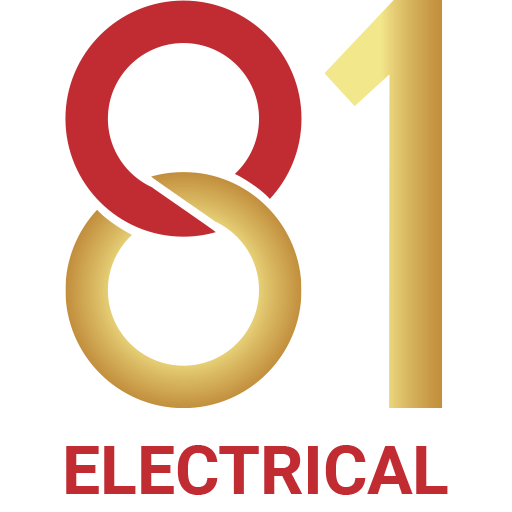Guide to Setting Up Electrical Wiring in Singapore's HDB Flats
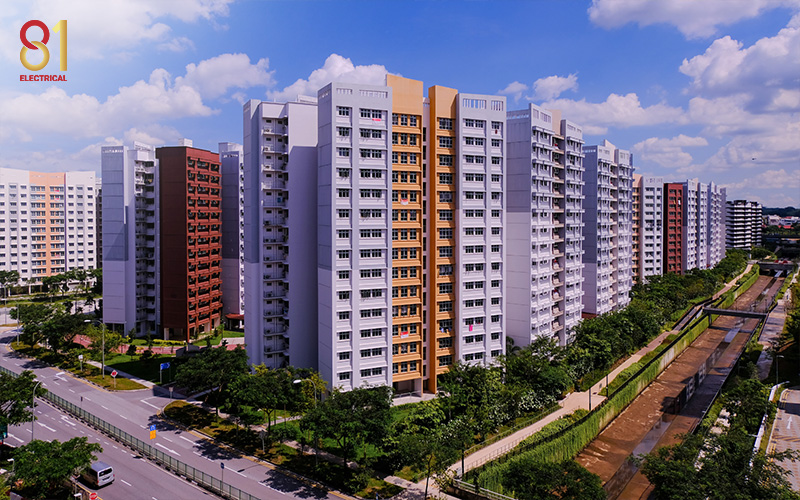
Introduction
Electrical cabling is a key aspect of modern living, maintaining the safe and efficient operation of all electrical appliances and systems within homes, offices, and public spaces. In Singapore’s Housing and Development Board (HDB) flats, proper electrical installation is essential for delivering power to daily household appliances such as lights, air conditioning, and entertainment devices. If electrical systems are improperly set up by the HDB electrician, they can pose serious risks such as electrical fires or electric shocks.
The safety of electrical setups in HDB flats is especially important due to the high population density and shared infrastructure. As such, employing professional electrical services plays a crucial role in avoiding electrical hazards that may lead to bigger problems like power failure.
Understanding Electrical Components in Residential Flats
Learn the roles of key electrical components to ensure safe and efficient power distribution in residential flats.
4 Common Types of Electrical Cabling in Flats
Electrical cabling powers everything from basic lighting and appliances to more complex systems like air conditioning and internet connections. There are several types of electrical cabling in local homes and apartments, each chosen based on specific functions and household needs. Here are the most common ones:
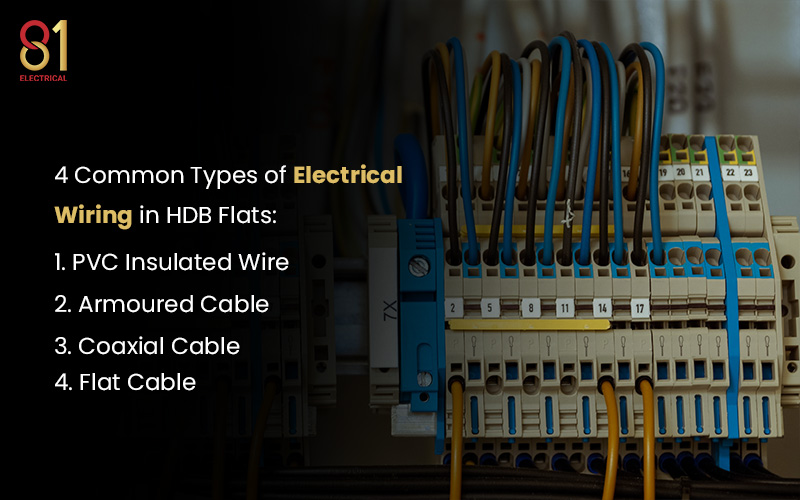
1. PVC Insulated Wire
Primarily used indoors to handle significant electrical loads from multiple household applications, PVC wires are known for their insulation properties. They offer excellent resistance against electrical leakage for reduced risk of accidental contact with live wires.
2. Armoured Cable
Thanks to their durability, armoured cables are commonly deployed for underground cable installation or in areas requiring greater resilience. Their robust protective layers shield the cables from physical damage caused by heavy machinery, excavation work, or environmental conditions like moisture and soil pressure.
3. Coaxial Cable
This type of cable is specifically designed for cable TV and internet connections. Its insulation effectively blocks signal interference to facilitate uninterrupted service delivery.
4. Flat Cable
When traditional round cables are impractical, flat cables serve as a practical alternative. You may find them often installed in modular furniture or locations where discreet cable placement is needed.
Types of Electrical Installation Techniques
The method of electrical setup can vary depending on the layout and aesthetic preferences of the home. If you’re unsure which best suits your home’s structure, seek professional advice from a licensed electrician in Singapore.
Common installation techniques include:
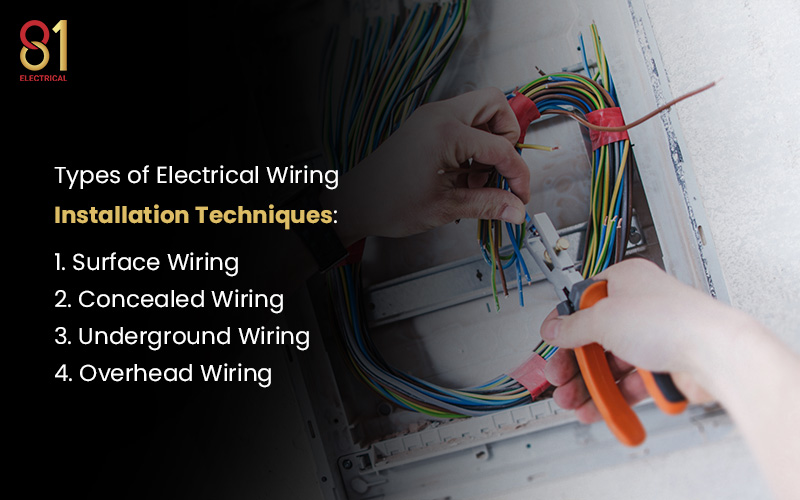
1. Surface Wiring
This method involves routing cables along walls or ceilings. It is often adopted when concealing cable routes is impractical or during the retrofitting of an older flat.
2. Concealed Wiring
A popular technique in modern homes, concealed cable routing hides the wires within walls or ceilings. It is ideal for achieving a clean and uncluttered look.
3. Underground Wiring
Best suited for outdoor spaces like gardens or driveways, underground cable routing protects cables from environmental elements.
4. Overhead Wiring
This technique is typically used for temporary connections, such as in construction projects or events where underground cabling is not feasible.
Regulations and Standards for Electrical Work in Flats
In Singapore, certain residential electrical works require a permit before they can be carried out, as outlined in government regulations. Even when a permit is not necessary for specific tasks, adherence to stipulated guidelines is essential to ensure compliance and safety. Unauthorised electrical work can lead to safety hazards and legal issues.
Before proceeding with electrical installations or air-conditioner setups, homeowners must apply for the required permit. This can be done through the Electrical Loading of Your Block e-Service with a licensed electrical contractor. Ensuring compliance with safety standards is critical, and all electrical work must only commence after official approval is granted.
For housing units with standard electrical loading, a permit should be obtained to install new 15-amp power points for high-capacity appliances. Below is an overview of regulations applicable to certain types of electrical installations:
1. New 15-Amp Power Points or 20-Amp Isolator
Appliances exceeding a 15-amp rating are not allowed. Meanwhile, the 20-amp isolator is exclusively approved for air-conditioner installations.
2. For flats with a 30-amp main switch, additional conditions apply:
- To comply with residential electrical standards and ensure safety, avoid embedding wiring within reinforced concrete elements like slabs, beams, columns, walls, or plaster finishes.
- Ensure you submit the appropriate forms for testing the newly installed wiring, as required by the regulations, to confirm its safety and compliance.
Following these residential electrical regulations ensures both safety and compliance, safeguarding your home’s electrical system while preventing potential hazards.
Learn more: What to Do When There Is a Power Outage in Your HDB Flat
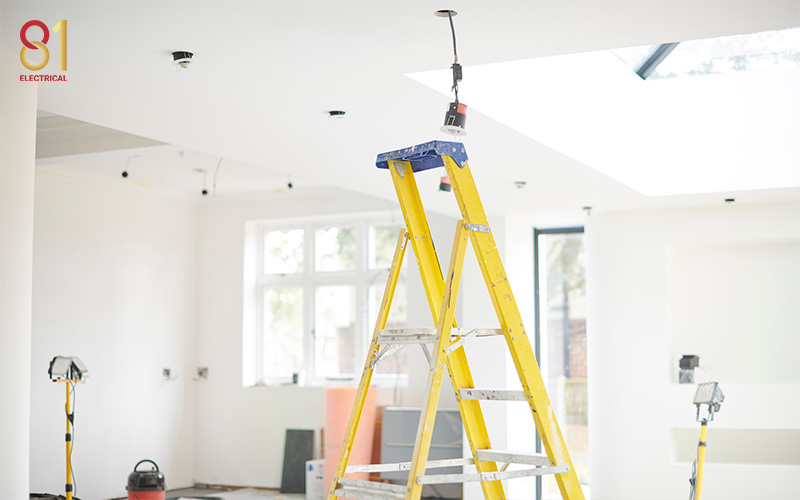
Engaging Professional Electrical Services
What You Need to Know Before Upgrading Your Home’s Electrical System
Regarded as a foundational step in any new construction, electrical cabling is the process of installing the electrical infrastructure in a new building or space. It covers laying out a new circuit system, connecting outlets and switches, and linking everything to the main power supply.
In contrast to electrical infrastructure setup, system upgrading refers to the upgrading or replacement of existing electrical components. This is often necessary when the existing setup has become outdated or shows signs of wear and tear. It is also a critical requirement when adding new electrical appliances or increasing the overall capacity of the system.
Signs Your Home’s Electrical System May Need an Upgrade
1. Damaged or Frayed Wires
This issue may pose significant hazards. Look out for signs such as peeling insulation or visible cracks.
2. Overheating Electrical Switches or Plugs
Switches or outlets should not feel warm to the touch. If they do, contact a licensed electrician to check for underlying electrical issues.
3. Frequent Tripping of Circuit Breakers
Regularly tripping circuit breakers suggests there may be an issue with the electrical system that requires attention.
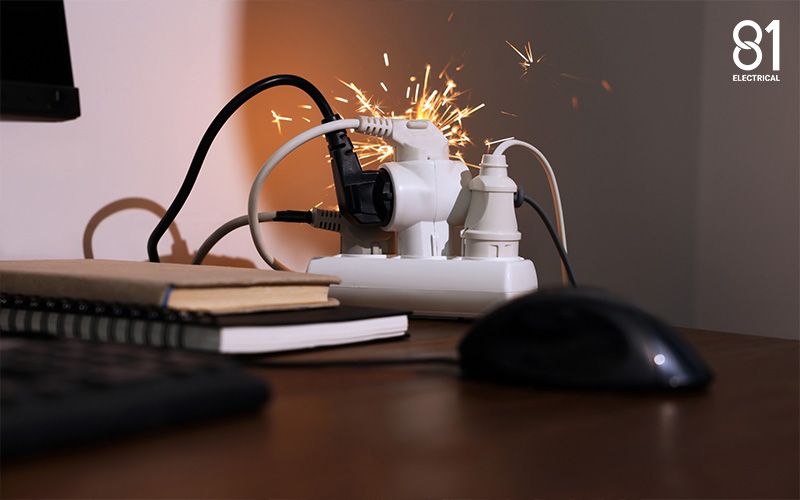
4. Dimming or Flickering Lights
If lights dim when other appliances are used, it could indicate an electrical fault.
5. Visible Smoke or Scorch Marks
If you notice smoke or scorch marks, immediately turn off the main power to prevent further damage.
Learn more: Insights from Professional Electricians in Singapore: Common Causes of Power Trips
Factors That Affect the Cost of Upgrading Electrical Systems in Singapore
The overall cost of electrical reconfiguration in flats and apartments depends on various factors. By understanding these, you can better plan your budget and make informed decisions.
1. Size of the Space
Larger flats require more electrical connections to connect all outlets, lights, and appliances, which increases both material and labour costs.
2. Cost of Materials
Premium materials offer enhanced protection against wear and tear, electrical faults, and environmental factors, contributing to a safer and more reliable infrastructure over the long term.
3. Adding or Upgrading Power Outlets
If you need additional power outlets or need to upgrade existing ones, this will increase the cost of electrical work
4. Labour Costs
The cost of labour for electrical installation depends on the project’s scope and complexity.
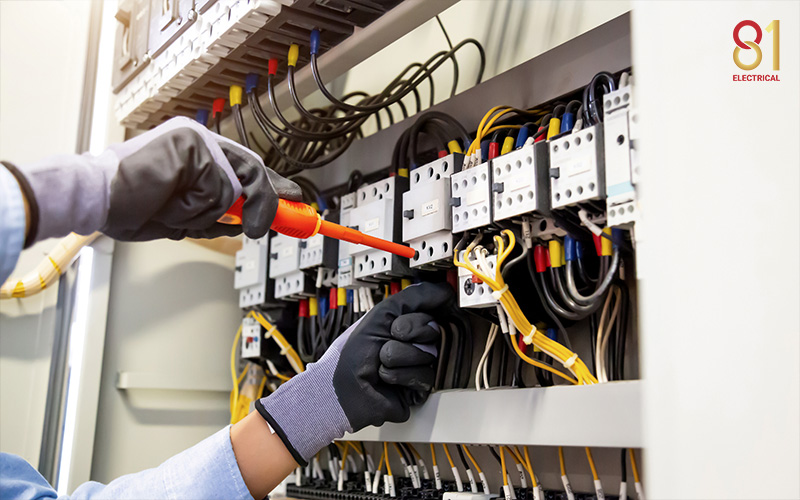
5. Type of Electrical Work
Rewiring projects that upgrade electrical load capacity or add surge protection tend to cost more due to the expertise and planning required.
Safeguard Your Home and Appliances with 81 Electrical
At 81 Electrical, our licensed and experienced team takes pride in providing thorough inspections and prompt rectifications to keep your home safe and efficient.
1. Decade of Experience and Industry Expertise
With over 10 years of experience, 81 Electrical has built a reputation for delivering quality electrical solutions in Singapore.
2. Award-Winning Service with a Commitment to Excellence
As an award-winning company, we maintain high standards in all our services, focusing on preventing potential hazards.
3. Comprehensive Electrical Inspections for Safety and Compliance
We go beyond just rectifications, offering detailed inspections to ensure your electrical system is safe and compliant with regulations.
Price Range of Electrical Services
81 Electrical offers a wide range of services, including electrical installations, with pricing that accommodates both exposed and concealed cable layouts. Services are typically priced from $50 to $400, depending on the complexity of the installation.
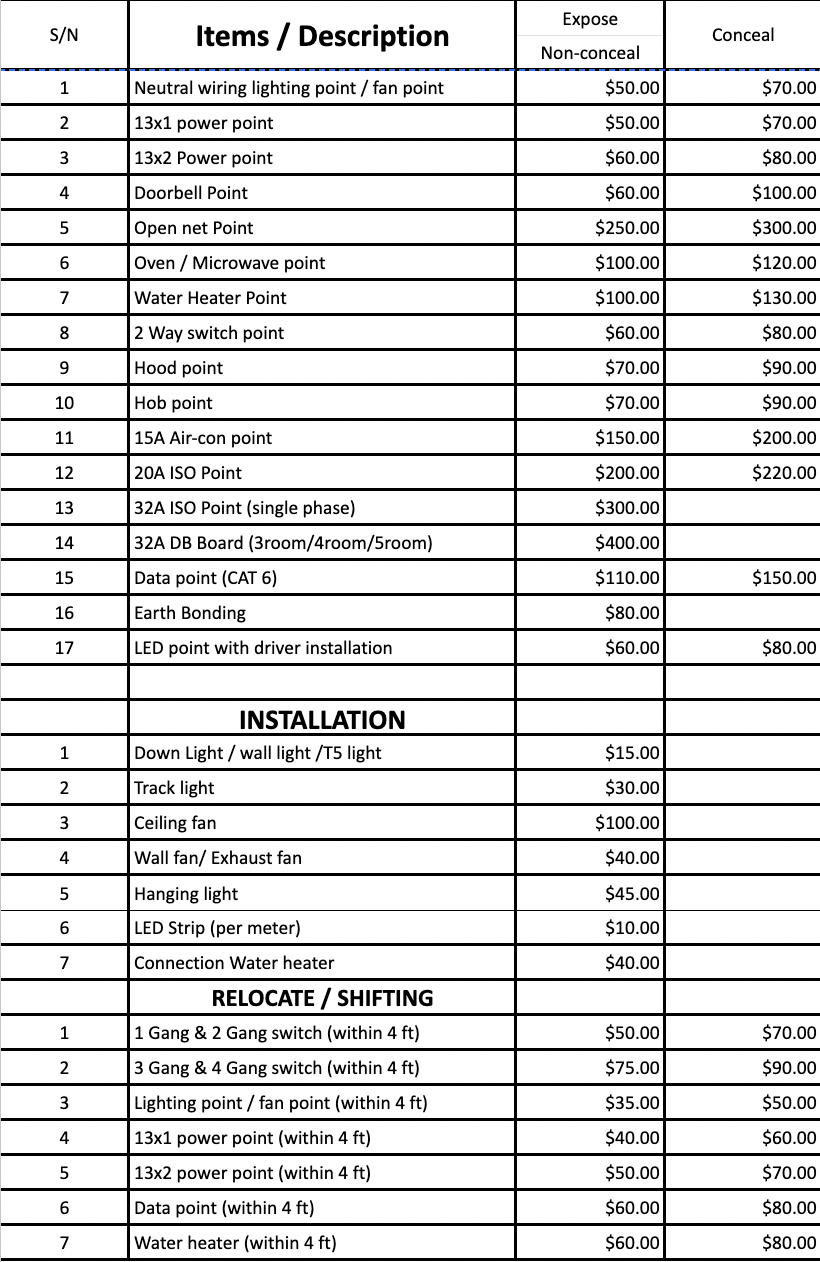
Frequently Asked Questions
1. What should I do before starting any electrical work in my flat?
Ensure that you have obtained the necessary permit from HDB and that the work is carried out by a licensed professional.
2. Can I Perform Minor Electrical Repairs Myself?
Minor repairs like changing light bulbs can be done, but significant electrical work should be left to a licensed professional.
3. How do I ensure that my electrical system remains safe over time?
Regular inspections and maintenance by a licensed electrician are essential for safety.
4. Can I upgrade my electrical system to accommodate new appliances?
Yes, but it must be done by a licensed electrician who ensures compliance with safety regulations.
5. How can I prevent electrical fires caused by wiring in Singapore?
Avoid overloading circuits, maintain wiring, and have your electrical system inspected regularly.
Conclusion
For new installations, renovations, or ongoing maintenance, proper electrical installation procedures in HDB flats help safeguard your residence and ensure functionality. Engaging a Licensed Electrical Worker (LEW) guarantees compliance with safety standards.
For dependable electrical installation services and a hassle-free experience, choose 81 Electrical. Our licensed electricians carry out each task with care and attention to safety.
To find out more about our electrical services, contact us today.
